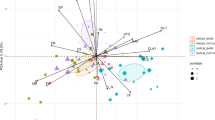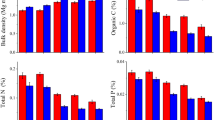Abstract
One of the major reasons for desertification is unrestricted grazing leading to vegetation depletion, soil erosion and degradation, phenomena often considered irreversible in the short term. Here, we compare soil and biological parameters of degraded and conserved, recently rehabilitated arid shrubland in the Northern Negev, Israel. The study area was restored by conservation efforts including a strictly controlled grazing regime initiated in 1992. The visually recognizable improvement in the ecology of the restored shrubland is reflected in significant improvement in all examined biotic (herbaceous biomass, shrub patch density, and insect activity), and soil parameters (nutrients, organic matter content, moisture, and water infiltration). The difference is created predominantly by restoration of large biological patches composed of shrubs and other perennial plants often associated with ant or termite nests, where the most significant increases in productivity and soil quality were observed. In the conserved shrubland such patches covered 35 or 25 % of the area (in a normal and a drought year, respectively). In the degraded shrubland 5 % or less of the area was occupied by such patches that were much smaller and of lower biological complexity. With respect to plant biodiversity, six plant species were found only—and 18 others became significantly more common—in the rehabilitated area. The results of this article indicate that functional arid drylands can be restored within <16 years relying on strict conservation management with reduced grazing intensity.







Similar content being viewed by others
References
Abd El-Ghani MM (1997) Environmental correlates of species distribution in arid desert ecosystems of eastern Egypt. J Arid Environ 38:297–313
Aguiar M, Sala OE (1999) Patch structure, dynamics and implications for the functioning of arid ecosystems. Tree 14(7):273–277
Aronson J, Floret C, LeFloc’h E, Ovalle C, Pontanier R (1993) Restoration and rehabilitation of degraded ecosystems in arid and semi-arid lands. II. Case Studies in Southern Tunisia, Central Chile and Northern Cameroon. Restor Ecol 1(3):168–187
Asner GP, Elmore AJ, Martin RE, Harris AT (2004) Grazing systems, ecosystem responses and global change. Ann Rev Environ Resour 29:99–261
Bestelmeyer BT, Ward JP, Havstad KM (2006) Soil geomorphic heterogeneity governs patchy vegetation dynamics at an arid ecotone. Ecology 87:963–973
Boeken B, Orenstein D (2001) The effect of plant litter on ecosystem properties in a Mediterranean semi-arid shrubland. J Veg Sci 12:825–832
Boulton AM, Kendi FD, Ward PS (2005) Species richness, abundance, and composition of ground-dwelling ants in Northern California grasslands: role of plants, soil, and grazing. Environ Entomol 34(1):96–104
Breshears DD, Barnes FJ (1999) Interrelationships between plant functional types and soil moisture heterogeneity for semiarid landscapes within the grassland/forest continuum: a unified conceptual model. Landscape Ecol 14(5):465–478
Chesson P, Gebauer RLE, Schwinning S, Huntly N, Wiegand K, Ernest MSK, Sher A, Novoplansky A, Weltzin JF (2004) Resource pulses, species interactions, and diversity maintenance in arid and semi-arid environments. Oecologia 141(2):236–253
Dregne HE, Chou N-T (1992) Global desertification dimensions and costs. In: Degradation and restoration of arid lands. Texas Tech. Univ. Press, Lubbock. http://www.ciesin.org/docs/002-186/002-186.html
Dunkerley DL (2002) Infiltration rates and soil moisture in a groved mulga community near Alice Springs, arid central Australia: evidence for complex internal rainwater redistribution in a runoff–runon landscape. J Arid Environ 51(2):199–219
Eldridge DJ, Zaady E, Shachak M (2000) Infiltration through three contrasting biological soil crusts in patterned landscapes in the Negev, Israel. Catena 40(3):323–336
Fischer RA, Turner NC (1978) Plant productivity in the arid and semiarid zones. Ann Rev Plant Physiol 29:277–317
Golodets C, Boeken B (2006) Moderate sheep grazing in semiarid shrubland alters small-scale soil surface structure and patch properties. Catena 65:285–291
Graetz RD, Tonngway DJ (2006) Influence of grazing management on vegetation, soil structure and nutrient distribution and the infiltration of applied rainfall in a semi-arid chenopod shrubland. Aust J Ecol 11(4):347–360
Greenwood KL, McKenzie BM (2001) Grazing effects on soil physical properties and the consequences for pastures: a review. Aust J Exp Agric 41(8):1231–1250
Gutierrez JL, Jones CG (2006) Physical ecosystem engineers as agents of biogeochemical heterogeneity. Bioscience 56(3):227–236
Helman D, Mussery A, Lensky IM, Leu S (2014) Detecting changes in biomass productivity in different land management regimes in drylands using satellite-derived vegetation index. Soil Use Manage 30:32–39
Hille RisLambers R, Rietkerk M, van den Bosch F, Prins HT, de Kroon H (2001) Vegetation pattern formation in semi-arid grazing systems ecology: Ecology 82(1):50–61. http://igitur-archive.library.uu.nl/milieu/2008-0111-200607/rietkerk-01-veg%20pattern.pdf
Hogan C (2012) Overgrazing. http://www.eoearth.org/view/article/155088
Huxman TE, Snyder KA, Tissue D, Leffler AJ, Ogle K, Pockman WT, Sandquist DR, Potts DL, Schwinning S (2004) Precipitation pulses and carbon fluxes in semiarid and arid ecosystems. Oecologia 141:254–268
Illius AW, O’Connor TG (1999) On the relevance of nonequilibrium concepts to arid and semi-arid grazing systems. Ecol Appl 9(3):798–813
Jouquet P, Dauber J, Lagerlo J (2006) Soil invertebrates as ecosystem engineers: intended and accidental effects on soil and feedback loops. Appl Soil Ecol 32:153–164
Kassas M (1995) Desertification: a general review. J Arid Environ 30(2):455–464
Kéfi S, Rietkerk M, Alados CL, Pueyo Y, Papanastasis VP, ElAich A, de Ruiter PC (2007) Spatial vegetation patterns and imminent desertification in Mediterranean arid ecosystems. Nature 449:213–217
Kefi S, Alados CL, Chaves Y, Pueyo Y, Rietkerk M (2010) Is the patch size distribution of vegetation a suitable indicator of desertification processes? Comment. Ecology 91(12):3739–3742
Lavee H, Imeson AC, Sarah P (1998) The impact of climate change on geomorphology and desertification along Mediterranean arid transect. Land Degrad Dev 9:407–422
Lesschen JP, Cammeraat LH, Kooijman AM, Van Wesemael B (2008) Development of spatial heterogeneity in vegetation and soil properties after land abandonment in a semi-arid ecosystem. J Arid Environ 72(11):2082–2092
Leu S, Mor-Mussery A, Lensky I (2011) GIS analysis of biological productivity and vegetation cover in a diverse arid landscape in the Northern Negev; February 21–24, 2011, Haifa, Israel. http://agri-sensing.technion.ac.il/Lectures%20PDF/Rangelands/Leu.pdf
Ludwig JA, Wilcox BP, Breshears DD, Tongway DJ, Imeson AC (2005) Vegetation patches and runoff-erosion as interacting ecohydrological processes in semiarid landscape. Ecology 86(2):288–297
Mor-Mussery A, Leu S, Budovsky A (2013) Modeling the optimal grazing regime of Acacia victoriae silvopasture in the Northern Negev, Israel. J Arid Environ 94:27–36
Oba G, Vetaas OR, Stenseth NC (2001) Relationships between biomass and plant species richness in arid-zone grazing lands. J Appl Ecol 38:836–845
Olsvig-Whittaker L, Frankenberg E, Perevolotsky A, Ungar EG (2006) Grazing, overgrazing and conservation: changing concepts and practices in the Negev rangelands. Sécheresse. 17(1): 195–199. http://www.john-libbey-eurotext.fr/en/revues/agro_biotech/sec/edocs/00/04/1F/12/resume.phtml?type=text.html
Osem Y, Perevolotsky A, Kigel J (2002) Grazing effect on diversity of annual plant communities in a semi-arid rangeland: interactions with small-scale spatial and temporal variation in primary productivity. J Ecol 90(6):936–946
Osem Y, Perevolotsky A, Kigel J (2007) Interactive effects of grazing and shrubs on the annual plant community in semi-arid Mediterranean shrublands. J Veg Sci 18:869–878
Pablo CA, Martin A (2006) Effects of grazing on patch structure in a semi-arid two-phase vegetation mosaic. J Veg Sci 16(1):57–66
Pantis J, Margaris NS (1988) Can systems dominated by asphodels be considered as semi-deserts? Int J Biometeorol 32:87–91
Safriel U, Adeel Z (2005). Dryland systems, in: ecosystems and human well-being: current state and trends. Millennium ecosystem assessment series, vol 1. Island Press. http://www.millenniumassessment.org/documents/document.291.aspx.pdf
Sall J, Lehman A (1996) JMP® Start statistics, chapter 6 (the difference between two means) and chapter 7 (comparing many means, one way analysis of variance). SAS Institute, Duxbury Press, Belmont
Sava R (1994) Guide to sampling, air, water, soil and vegetation for chemical analysis. Environmental Protection Agency, Department of Pesticide Regulation, Environmental Monitoring and Pest Management Branch, California
Sparks DL (1999) Environmental soil chemistry, 2nd edn. Academic Press, San Diego
Steinberger Y, Leschnert H, Shmida A (1992) Activity pattern of harvester ants (Messor spp.) in the Negev desert ecosystem. J Arid Environ 23:169–176
USDA (1999) Soil taxonomy a basic system of soil classification for making and interpreting soil surveys, 2nd edn. United State Department of Agriculture Natural Resources Conservation Service
Wagner D, Jones JB (2004) The contribution of harvester ant nests, Pogonomyrmex rugosus (Hymenoptera, Formicidae), to soil nutrient stocks and microbial biomass in the Mojave desert. Environ Entomol 33(3):599–607
Whittaker RH (1972) Evolution and measurement of species diversity. Taxon 21(2/3):213–251
Zaady E (2005) Seasonal change and nitrogen cycling in a patchy Negev desert: a review. Arid Land Res Manage 19:111–124
Acknowledgments
We wish to thank the Oren and Eren families, the Yattir farm owners, for their help in implementing this research. We also thank the Israel Ministry of Science and the Wadi Attir association (Sustainable agriculture community) for sponsoring this project, and above all to Dr. Bert Boeken on his helpful comments and species analyses.
Author information
Authors and Affiliations
Corresponding author
Appendix
Appendix
Absence: The species is absent from the studied shrubland (Grazed or Conserved).
Rare: The species appears in one plot in the studied shrubland (from “up,” “middle,” and “down” plots, Fig. 1).
Common: The species appears in two or three plots in the studied shrubland.
Latinist name | Conserved | Grazed | |
|---|---|---|---|
Forbs | |||
1 | Adonis dentata | Rare | Common |
2 | Anagallis arvensis | Absence | Rare |
3 | Arnebia decumbens | Rare | Rare |
4 | Artemisia crassifolia | Rare | Absence |
5 | Asteriscus pygmaeus | Common | Common |
6 | Astragalus cretaceus | Rare | Common |
7 | Astragalus tribuloides | Common | Absence |
8 | Bupleurum nodiflorum | Absence | Rare |
9 | Carthamus tenuis | Common | Common |
10 | Centauria hyalolepis | Common | Common |
11 | Cnicus beneficus | Rare | Rare |
12 | Dianthus strictus | Common | Rare |
13 | Echinops polyceras | Common | Absence |
14 | Filago contracta | Rare | Rare |
15 | Gundelia tourneforti | Common | Common |
16 | Heliotropium europaeum | Rare | Rare |
17 | Helianthemum lediflorum | Rare | Absence |
18 | Herniaria hirsuta | Absence | Rare |
19 | Hippocrepis unisiliquosa | Rare | Rare |
20 | Hymenocarpos circinnatus | Rare | Absence |
21 | Hormuzakia aggregata | Common | Absence |
22 | Medicago laciniata | Common | Rare |
23 | Neotorularia torulosa | Rare | Rare |
24 | Onobrychis cristata | Rare | Common |
25 | Paronychia argentea | Rare | Absence |
26 | Plantago coronopus | Absence | Common |
27 | Pterocephalus brevis | Absence | Rare |
28 | Reboudia pinnata | Rare | Rare |
29 | Roemeria hybrida | Absence | Rare |
Shrubs | |||
30 | Atractylis serratuloides | Rare | Rare |
31 | Helianthemum ventosum | Rare | Absence |
32 | Noaea mucronata | Rare | Absence |
33 | Phagnalon rupestre | Common | Absence |
Cryptophytes | |||
34 | Allium stamineum | Common | Rare |
35 | Asphodelus racemosus | Rare | Common |
36 | Carex pachystyla | Common | Common |
37 | Gynandriris sisyrhinchium | Common | Common |
38 | Scorzonera papposa | Rare | Rare |
Hemi cryptophytes | |||
39 | Astragalus cichrous | Common | Rare |
40 | Gypsophila arabica | Rare | Rare |
41 | Eryngium creticum | Rare | Rare |
42 | Salvia lanigera | Absence | Rare |
Graminoids | |||
43 | Avena barbata | Common | Absence |
44 | Broumus fasciculatus | Rare | Absence |
45 | Convolvulus lanatus | Rare | Absence |
46 | Rostraria cristata | Rare | Absence |
47 | Schismus arabicus | Common | Common |
48 | Stipa capensis | Common | Common |
49 | Vulpia ciliaris | Absence | Rare |
Rights and permissions
About this article
Cite this article
Leu, S., Mussery, A.M. & Budovsky, A. The Effects of Long Time Conservation of Heavily Grazed Shrubland: A Case Study in the Northern Negev, Israel. Environmental Management 54, 309–319 (2014). https://doi.org/10.1007/s00267-014-0286-y
Received:
Accepted:
Published:
Issue Date:
DOI: https://doi.org/10.1007/s00267-014-0286-y




